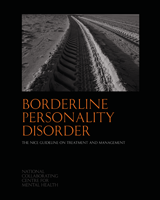All rights reserved. No part of this book may be reprinted or reproduced or utilised in any form or by any electronic, mechanical, or other means, now known or hereafter invented, including photocopying and recording, or in any information storage or retrieval system, without permission in writing from the publishers. Enquiries in this regard should be directed to the British Psychological Society.
NCBI Bookshelf. A service of the National Library of Medicine, National Institutes of Health.
National Collaborating Centre for Mental Health (UK). Borderline Personality Disorder: Treatment and Management. Leicester (UK): British Psychological Society (UK); 2009. (NICE Clinical Guidelines, No. 78.)
A large number of outcomes are reported by intervention studies in people with borderline personality disorder no doubt because of the multi-symptom nature of the disorder, and the fact that the diagnosis does not include core symptoms as is the case for other mental disorders, such as depression. The problem is compounded by the large number of rating scales available to measure each outcome, including both clinician- and self-rated versions. The problem is further exacerbated by the relatively low number of studies undertaken in people with borderline personality disorder.
To address these problems, the GDG drew up a list of outcomes reported in RCTs reviewed by two existing systematic reviews, one of pharmacological treatments (Binks et al., 2006a) and the other of psychological treatments (Binks et al., 2006b). Each outcome was then allocated to a category (for example, symptoms – depression, harm, general psychiatric morbidity). The outcomes reported within each category were then examined to assess whether they could be combined in meta-analysis. This was done by examining the scales (where relevant publications were available and/or using handbook published by the APA [2000]) to assess how many items they had in common. This was undertaken initially for those outcomes reported in the pharmacological studies. A special advisor with expertise in undertaking trials in people with borderline personality disorder was appointed to advise with this process (see Appendix 3).
The following general rules were adopted when deciding whether to include or exclude a rating scale. The scale had to have been published in a peer-reviewed journal (including validation data), and it had to report an outcome relevant to the guideline. When deciding whether to combine scales in meta-analysis, the following additional rules were adopted: clinician-rated scales were not combined with self-report scales, and the items in the scale had to fairly closely match another scale to be combined.
As studies were reviewed by the GDG that were not included in the existing systematic reviews used to draw up the initial outcome lists, additional outcomes were added to the master list. These were assessed in the same way. Note that dichotomous outcomes based on simple events counts, such as number of episodes of self-harm, were not part of this exercise.
The list of outcomes is in Table 124 together with some notes. Table 125 shows scales arranged by category (domain) with notes on whether they were considered combinable in meta-analysis. Table 126 suggests a possible ranking of the outcomes.
Table 124
Outcomes reported by RCTs reviewed for the guideline.
Table 125
Rating scales by domain with notes on possibility of combining scales in meta-analysis.
Table 126
Proposed ranking of the outcomes – by importance.
- OUTCOMES - Borderline Personality DisorderOUTCOMES - Borderline Personality Disorder
Your browsing activity is empty.
Activity recording is turned off.
See more...
